| Date |
February 15, 2019
|
|---|---|
| Content Type |
User Story
|

|
|
| Data Applications |
Ecosystem Monitoring
|
Salmon sharks are apex predators found in the North Pacific. Juvenile salmon sharks are known to utilize nursery areas in the North Pacific Transition Zone and the California Current System.

Standings of small juvenile salmon sharks have been reported between British Columbia, Canada and northern Baja California. A recent study used CoastWatch sea surface temperature data from the west coast regional node to explore the link between salmon shark strandings and water temperature. The study found that the probability of shark strandings was greatest when sharks were exposed to acute cold-water coastal upwelling events.

References and Related Reading
- Carlisle, A.B., S.Y. Litvin, E.L. Hazen, D.J. Madigan, K.J. Goldman, R.N. Lea, and B.A. Block. 2015. Reconstructing habitat use by juvenile salmon sharks links upwelling to strandings in the California Current. Marine Ecology Progress Series 525: 217-228. Cannizzaro, J., K. Carder, F. Chen, C. Heil, and G. Vargo. 2008.
- Compagno, L.J.V. 2001. Sharks of the world, Vol 2. Bullhead, mackerel and carpet sharks (Hetero dontiformes, Lamniformes and Orectolobiformes). FAO Species Catalogue for Fishery Purposes No. 1. FAO, Rome.
- Goldman, K.J., and J.A. Musick. 2006. Growth and maturity of salmon sharks (Lamna ditropis) in the eastern and western North Pacific, and comments on back-calculation methods. Fish Bulletin 104: 278-292.
- Schaffer P.A., B. Lifland, S. Van Sommeran, D.R. Casper, and C.R. Davis. 2013. Meningoencephalitis associated with Carnobacterium maltaromaticum-like bacteria in stranded juvenile salmon sharks (Lamna ditropis). Veterinary Pathology 50: 412-417.
